Spiders In Kentucky – The Brown Recluse
BROWN RECLUSE SPIDER IN KENTUCKY
Brown Recluse Spiders in Kentucky– To some of us, they are the things nightmares are made of. Some folks freeze in fear at the sight of one. They can make you produce blood-curdling screams and throw shoes at a wall. Spiders. Eight-Legged Freaks. Demons from Hell. Call them what you will; most spiders are harmless to you and your family. But some are not. Of the hundreds of species of spiders that call Kentucky home, none are as infamous (or misidentified) as the Brown Recluse. In my home inspection adventures, I see them way more than you would think, sometimes several times a week. Louisville, Kentucky, and the surrounding areas are packed with them.
The Brown Recluse, aka “The Fiddler,” which sounds more like a villain from Batman than a spider in your home, is one of the most dangerous venomous spiders in the United States and one of two in Kentucky (the Black Widow is the other). Loxosceles reclusa (if you want to geek out on the name) is found in the central Midwest. From Nebraska to Kentucky, from Iowa to Texas, and everywhere in between.
Perhaps I am more aware of these guys than other people, but I find lots of homes every year with Brown Recluses spiders in them during my home inspections in Louisville. A few of these have been serious infestations…I’m talking about hundreds of the spiders found by yours truly in one home, and I’m not really looking that hard for spiders, but when they pile up in bathtubs and sinks, you know you have a serious problem on your hands.
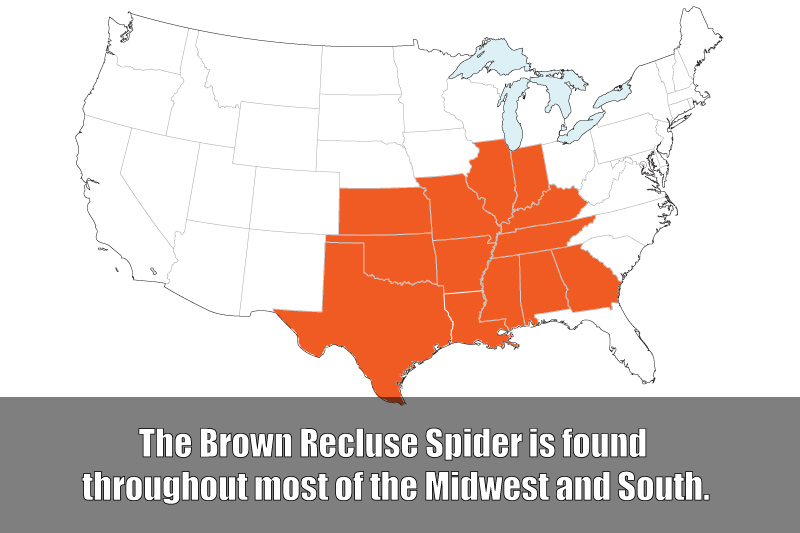
HOW TO IDENTIFY A BROWN RECLUSE SPIDER
The reality is, a lot of you who are reading this right now have a Brown Recluse spider or three in your garage, basement, or attic, and don’t even know it. Heck, you’ll likely never see them. They are, after all, a recluse…ba-dum-dum…I’ll see myself out.
But if you would like to be able to spot these dudes, here are the things I look for when I see a spider in a house. I’ve gotten so good at it I can spot a Brown Recluse spider from across the room.
- The Brown Recluse Spider is small. Really small. They are usually no bigger than a quarter, including the legs. The picture below was taken in a garage during a home inspection in Louisville, KY. Notice the size of the spider in relation to the head of that framing nail.
- They are…wait for it…Brown in color. Shocking, I know. However, this color spectrum can range from really dark brown to almost a creamy white.
- Most spiders have 8 eyes, but a Brown Recluse Spider only has 6. Legend has it that they lost two of their eyes in a bar fight a long time ago, but I am not able to substantiate this claim. Their eyes are hard to see due to one of two things: (1) The eyes are very small and you need magnification to see them clearly, or (2) it’s hard to count spider eyes while running in the opposite direction of the spider.
- And of course, as their nickname “The Fiddler” implies, the simplest way to identify them is to look for a fiddle-shaped marking on the cephalothorax (fancy name for their back). The fiddle or violin shape is their exclusive marking. No other spider will have this marking.
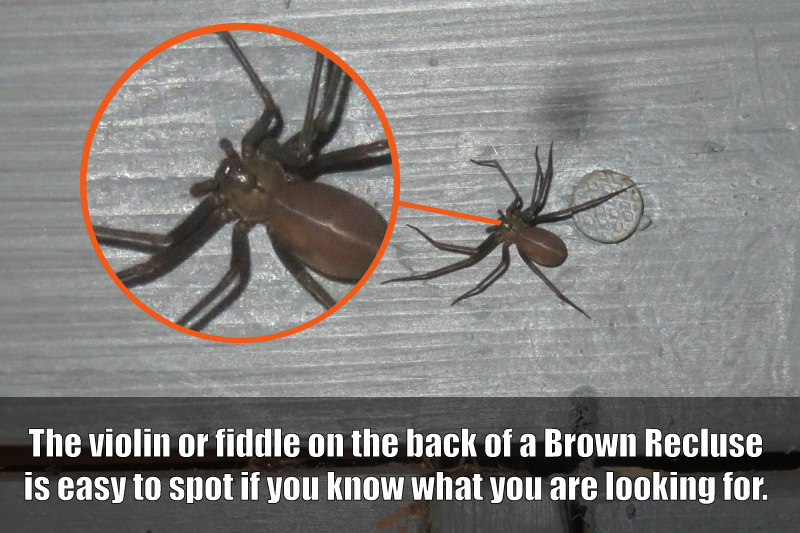
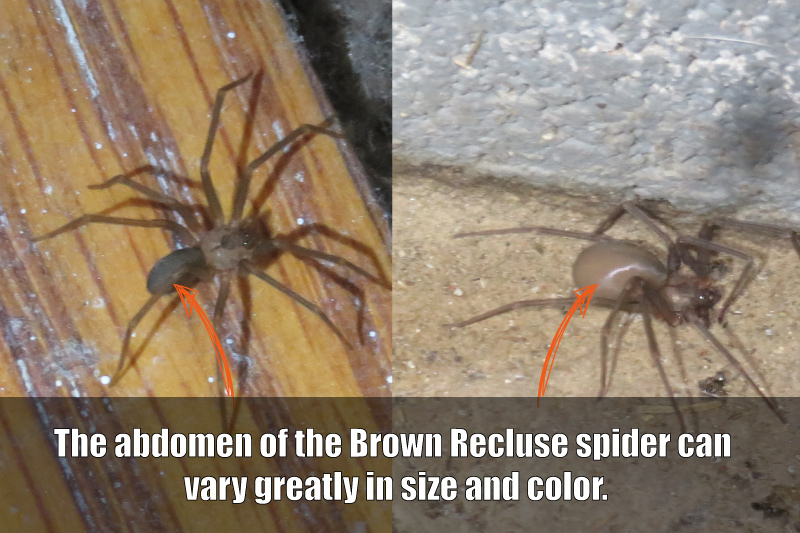

WHERE ARE BROWN RECLUSE SPIDERS HIDING?
As their name implies, the Brown Recluse spider is usually in dark places. They build irregular webs that frequently include a shelter consisting of random threads. During my home inspections, I see them mostly in:
- Woodpiles or stacked lumber in a shed or garage.
- Closets (especially around the ceiling)
- Just about everywhere in a crawlspace.
- Basements–around the rim joists (ceiling) and inside or around sump pumps.
- Attics, especially in insulation.
Brown Recluse spiders are more common than most people think. In fact, one of the largest infestations ever recorded was in Kansas in 2001. Over 2,000 brown recluse spiders were removed from a home where the people lived for years. Not one bite occurred in that house.
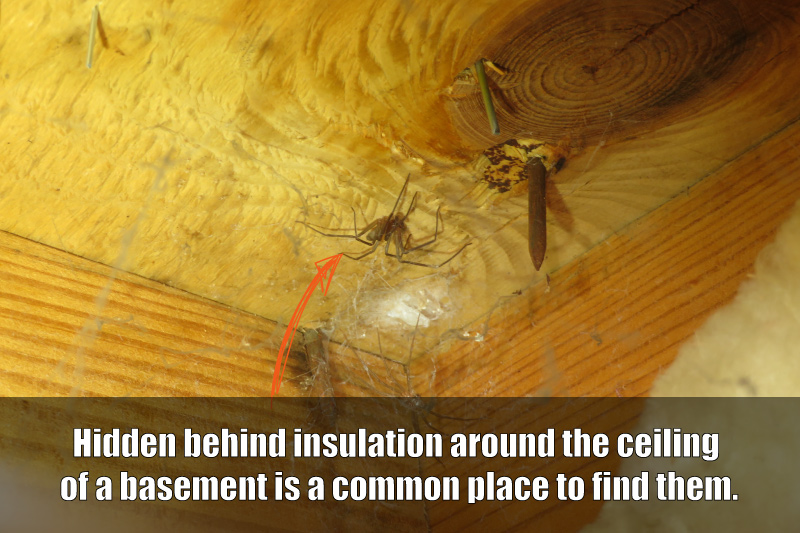
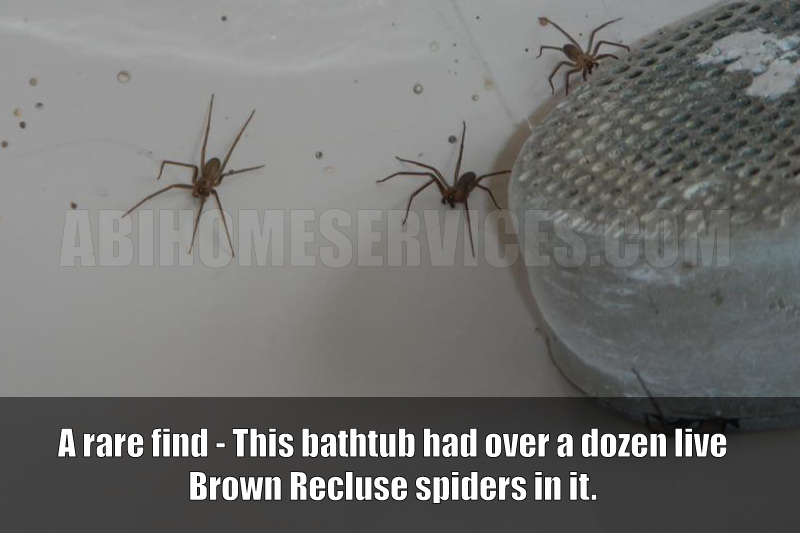

TREATMENT FOR BROWN RECLUSE SPIDERS
It’s important to remember that generally, Brown Recluse Spiders are not aggressive. In fact, they are usually the opposite. However, they will bite you if they are handled or feel threatened. A common cause of bites occurs from the spider becoming trapped in an article of clothing or shoe. They crawl in your old pants hanging in the closet, and when you put them on…you get bit.
Personally, I’ve not been bit. But I’ve read many reports where victims state that they never felt the bite happen, but the necrosis that takes place a few days later can be… gross. If you would like to see images of rotting flesh from a Brown Recluse bite, here you go. Click at your own risk: Google Images search of Brown Recluse Bites.
If you think you have been bitten by a Brown Recluse spider, you should try to catch the dude (dead or alive) and seek medical attention as fast as possible. Death from a Brown Recluse bite is extremely rare, but it has happened.
The odds of getting bit are really low if you don’t do stupid things like try and handle a Brown Recluse spider. If you think you may have them in your house you should call a pest control company. This is one of those times you don’t want to get all DIY. Most pros will want to set sticky traps in the areas where the spiders are most active. Give it a few days and then check the traps. This can help gauge how bad your problem is. Then you can develop a plan of attack. You can also break out the biological warfare (chemical spray) if needed, but understand that this usually takes multiple treatments and is not a one-time thing.
Though Brown Recluse bites are rare and the potential exists for you to cohabitate peacefully in your house with these bar-fighting arachnids, you don’t want to. If you see them, call a pro.
BROWN RECLUSE SPIDERS FAQ
I’ve gotten a lot of messages and several questions about Brown Recluse Spiders so I added this small FAQ section for quick answers. If you have question I haven’t covered feel free to ask.


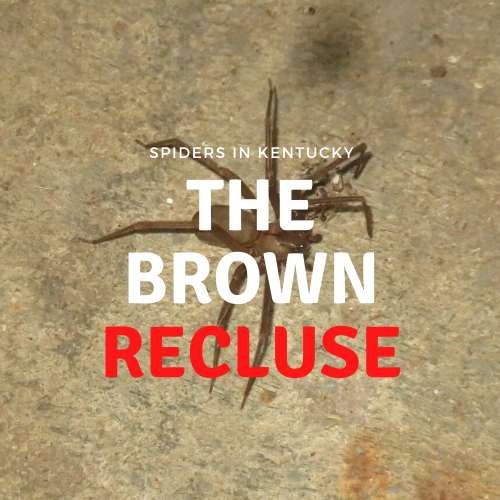




I did not know we had Brown Recluse spiders in Kentucky! Are there any other dangerous spiders that I should look out for in Kentucky? I live in Louisville.
Great question. The only other spider beside the Brown Recluse would be the Black Widow spider. Keep in mind that Black Widows are usually found outside the home, while Brown Recluse spiders are typically inside the home.
Ben, my family moved to Fl in 1979, but in the mid-1960s, my little brother, Greg, was bitten by a Brown Recluse Spider. At the time, no one had ever heard of it. He was probably 2 or 3 years old. There was a mark on his arm that my Mother thought was a spot of ink, like the touch of a ball-point pen, but it wouldn’t wash off. It then got a red circle around it. Within less than 48 hours, he was in an oxygen tent and they had him wrapped in cellophane. I guess with some kind of ointment. I was only about 4 or 5 myself, but I remember my parents praying and it didn’t sound like he was going to make it. I think it might have made the Courier-Journal because of it’s rarity at the time, I’m guessing 1966 or so. We had been playing in a wooded area next to a corn field off a road called Hunter’s Trace and we lived on Santa Fe Trail. Greg made a miraculous recovery. But that tiny little bastard of a spider nearly killed him. Oh, our name is Williams. His name is Greg Williams. I’m Joey Williams. Take care !
Oh. Duh ! We were in Louisville, Kentucky !